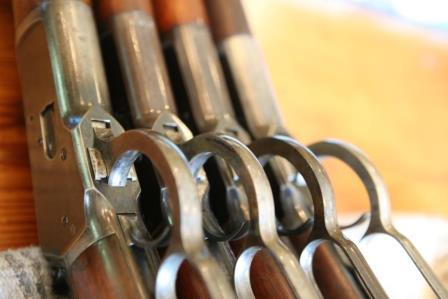April 15, 2005
 Offline
OfflineI suspect that "three option" refered to special order options.
The shotgun butt on a SRC is definitely a special order option. The half magazine was a standard option. The 3-leaf sight was optional, or in some configurations, standard.
Bert
WACA Historian & Board of Director Member #6571L

April 15, 2005
 Offline
Offlinejschaal said
No. Is that a variant that came on certain guns? I thought the fluted stocks came in the early 20’s. I figure this gun to be around 1912-1914.
Shortly after your SRC was manufactured, Winchester did begin to make the fluted comb butt stocks for the Model 1894s that were special ordered with a shotgun style stock & butt plate. With just a few rare exceptions, 1914 appears to be when the fluted comb made its debut. I (like you) originally thought that it occurred in the early 1920s, but a survey that I started a few years ago has proven otherwise.
Bert
WACA Historian & Board of Director Member #6571L

March 20, 2009
 Offline
OfflineI have cataloged one Model 1892 rifle from 1911, 3 from 1912, 3 from 1913, 3 from 1914, and 4 from 1915 as the earliest examples in that Model for having the fluted comb style shotgun butts. A number of these are carbines without a saddle ring and they may also have 1/2 or 2/3rd magazine lengths. Definitely special order guns.
Michael

Model 1892 / Model 61 Collector, Research, Valuation
April 15, 2005
 Offline
OfflineSB said
When does the serrated shotgun buttplate start to be seen?
March of 1921 based on what I have found thus far, but only as a special order item. The serrated steel butt plate was a standard item for the Models 53 and 55 starting in June of 1924 through the end of production. It was last used as a standard item on the Model 94 Carbines from 1937 – early 1946.
Bert
WACA Historian & Board of Director Member #6571L

April 23, 2012
 Offline
Offlinejschaal said
No. Is that a variant that came on certain guns? I thought the fluted stocks came in the early 20’s. I figure this gun to be around 1912-1914.
Shortly after your SRC was manufactured, Winchester did begin to make the fluted comb butt stocks for the Model 1894s that were special ordered with a shotgun style stock & butt plate. With just a few rare exceptions, 1914 appears to be when the fluted comb made its debut. I (like you) originally thought that it occurred in the early 1920s, but a survey that I started a few years ago has proven otherwise.
Bert
I also recall reading about the great fanfare Winchester promoted the Col Townsend Whelen designed fluted combs for the new models 53 & 55. How did the old/new "fluted comb style" differ?

July 7, 2011
 Offline
Offlinejschaal said
Bert were the smooth SB and the checkered SB offered concurrently? I ask because I have a rifle with the checkered SB from 1906 and the wood is noticeably of a higher grade. This leads to my next question. Were the checkered SB’s used on fancier grade wood?
If you have a rifle from 1906 with a checkered steel SB then yes, the smooth steel SB was being offered concurrently along with the hard rubber SB. My latest rifle with the smooth SB, s/n 376721, is from 1907.
Among my rifles, I would say that there is no noticable difference in the wood quality.
Paul
1 Guest(s)


 Log In
Log In




